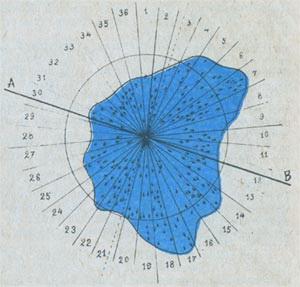1261
100 years since the Tunguska phenomenon.
So what happened June 30, 1908 near the Stony Tunguska, which has yet to cease debate and are born new hypothesis about the event? And this event marked a century the scientific community (eg, held June 26-28 International Conference "100 years since the Tunguska phenomenon: Past, Present, Future»)? ..
On the morning of June 30, 1908, many hundreds of inhabitants of Siberia watched the sky "fire flashed something" and disappeared into the north side of the eyewitnesses. The span of the body, observed from a distance of up to 400 km away from the disaster area, accompanied by a powerful sound phenomena, which could be heard at distances up to 1000 km. Witnesses who were on the Angara, ie approximately 200 kilometers from the crash site, describes this phenomenon is even more pronounced. "People were falling", "Fell horse", "Water on the Angara drove shaft", "We thought that was the end of the world».
It was over a grand explosion over the taiga at an altitude of about 10 kilometers. Witnesses were few disaster - residents Vanavara factories and the few Evenki nomads that were hunting near the epicenter of the explosion. The blast in a radius of about 40 km has been knocked down a forest destroyed by animals, people have suffered. Simultaneously, under the influence of light on dozens of kilometers around it broke the taiga. Start a fire destroyed the little that survived the explosion.

Driving forest fall around the epicenter of the Tunguska explosion of 'butterfly' with the axis of symmetry AB, taken as the main direction of the trajectory of the Tunguska meteorite.
For many years the taiga became a sad cemetery of dead wood. The study of the effects of the disaster showed that the energy of the explosion was equivalent to 10-40 megatons of TNT, which is comparable with the energy of 2000 at the same time exploded nuclear bombs dropped on Hiroshima. Air blast wave obognuvshaya the globe, has been registered in many of the world meteorological observatory.
At the crash site, as a result of the explosion, there was a partial mutation of plants, accelerated growth of trees has changed the chemical composition and physical properties of soils. The earthquake caused the explosion, it was noted in Irkutsk, Tashkent, Tbilisi, and in the German city of Jena. According to the director of the meteorological observatory of Irkutsk A.V.Voznesenskogo the first time in the history of science seismometers recorded aftershocks from a meteorite impact. Start earthquake accounted for 00 h. 17 min. 11 seconds Universal Time. The arrival of the air waves to the observatory, late on the 2nd, 5 minutes, which is subsequently allowed to set its speed equal to 318 - 321 m / s. It is still unclear how the explosion caused the change in 1908 of the magnetic field of the Earth. Magnetic Storm marked near Irkutsk, lasted about 3 5 hours.
Strange consequences of the collision of Earth with an unknown cosmic body is not limited to this. In the night from June 30 to July 1, ie, 15-20 hours after the disaster, on the western shores of the Atlantic to central Siberia, and from Tashkent to Saint Petersburg on an area of more than 12 million. Km2, began an unusual glow of Earth's atmosphere and night glowing clouds. Clouds formed at an altitude of about 80 kilometers, intensely reflect the sun's rays, thus creating the effect of light nights, even where they have not seen before. Shining sky was so strong that many people could not sleep. In some cities, at night you can freely read the newspaper, printed in small type, and at midnight Greenwich was obtained picture seaport. This phenomenon continued for several nights. One of the first scientists who gave an explanation of the phenomenon of optical anomalies was an English meteorologist Francis Whipple, assume that on this night the Earth collided with a small comet. Somewhat earlier, in 1927, Russian researcher Leonid Kulik expressed a different point of view. According to him, in Central Siberia was a large drop in iron meteorite. Under the leadership of L.A.Kulika ranging from 1927 to 1939. there have been several expeditions to the site of the disaster, but the meteorite has not been found.

Spill 180-year-old larch from the crash site (sample taken from a fallen tree after fire in the summer of 1994). In his annual rings clearly visible, as the accelerated growth of the tree immediately after the explosion. For the first time the effect of accelerated growth trees was discovered by YM Emelyanov and VI Nekrasov in 1958, but received no definitive explanation until now.
The main hypothesis of the nature of this phenomenon has been speculation that the Stony Tunguska fell large enough iron or stony meteorite. This hypothesis has successfully lasted until 1958. Later it became clear that this view is not able to explain a number of phenomena observed in the time of the disaster, and after it. First of all, it is not clear why the meteor exploded like explosives, and where his stuff was gone. It is unclear, as in this case could arise optical anomalies thousands of kilometers from the crash site. Why is the epicenter of the accelerated growth of plants? Both in terms of this hypothesis to explain the effect of a magnetic storm raging in the ionosphere directly after the explosion?
However, regardless of this, interest in the meteorite hypothesis unabated in our time. In 1993, a group of US scientists from NASA and the University of Wisconsin conducted a calculation according to which the Tunguska meteorite could be a small stone asteroid with a diameter of about 30 meters, exploded at an altitude of 8 kilometers.
An attempt to find a solution one of the mysteries of the twentieth century have taken not only the scientists. This boom in the popularity of the Tunguska meteorite emerged after the publication of the story AP Kazantsev, "Explosion" in which the author described the science fiction of the Tunguska catastrophe like an explosion interplanetary Mars Korablin. By comparing the description of the devastation in the Siberian taiga to what happened after the explosion of a nuclear bomb in Hiroshima, he came to the unexpected conclusion about the similarity of these two events.
In 1965, American physicists, Nobel Prize winners and K.Kouen V.Libbi, developing the idea of his compatriot L.Lapaza antimatter nature of the Tunguska meteorite, hypothesized about the collision of Earth with a mass of antimatter, so that there was annihilation and the release of a large number of nuclear power. And yet, despite the strong arguments from experts in the field of the Tunguska problem, nuclear hypothesis is supported by a large circle of enthusiasts.
Since 1958, the Committee on Meteorites of the USSR under the guidance of renowned geochemist K.P.Florenskogo conducting a series of expeditions to the site of the Tunguska catastrophe. At the same time, the unfolding investigation of the problem unique scientific and social community CSE (Complex amateur expedition), led in the early years biophysicist G.F.Plehanovym and then microbiologist N.V.Vasilevym. The main direction of the work was related to the search of cosmic matter, the study of the effects of the explosion and the definition of the parameters of the trajectory followed by the identification of a space body. These findings were unexpected. Firstly, the survey of more than 700 eyewitnesses showed an apparent contradiction in the direction of the car. It seemed that no one was moving, and several bodies with a significant spread from the southern to the eastern path, although there is no evidence, where witnesses saw two cars simultaneously. Second, thousands of samples taken from the crash site showed that the total amount of material sprayed in the forest, is unlikely to exceed two tons, and astronomers estimate academician V.G.Fesenkova, Tunguska cosmic body mass prior to entry into the atmosphere is 1 million .T. To explain this contradiction was not easy. The absence of large fragments of space substance at the site of the explosion caused the experts to remember comet hypothesis F.Uipla and I.S.Astapovicha proposed back in the 30s. Thoroughly developed V.G.Fesenkovym, G.I.Petrovym, V.P.Stulovym, V.P.Korobeynikovym and a number of other well-known experts, this hypothesis has become a working model of research for over 30 years. By the degree of scientific validity it deserves the most attention.
At the same time the beginning of the 60s was marked by a serious controversy between the supporters of nuclear and comet hypothesis. Arguments in favor of this or that point of view could be obtained only at the crash site. To do this, we studied the radioactivity of soil and plants to explore their isotopic and chemical composition. The first results of the field work revealed a complete absence of radioactive contamination. Subsequent study of the isotopic composition has proved not nuclear nature of the Tunguska explosion. And when stratified study upland peat were found fused silicate and magnetite microspheres space origin with a high content of elements such as aluminum, bromine, cesium, cobalt, lead, iron, ytterbium, sodium, zinc, and iridium (as it turned out, this element is especially space element because its concentration in the earth's crust is relatively small). The chemical composition of a substance collected from the crash site, approached the spectra of comets. Undoubtedly, it was an argument in favor of the comet hypothesis. But it still does not eliminate all the issues related to the problem.
Unfortunately, now confidently speak about the legitimacy of a hypothesis is not possible, since none of the presented to date point of view can not explain the whole complex of phenomena that accompanied the Tunguska explosion. This, in fact, lies the fundamental paradox of the problem. Because no hypothesis can not explain simultaneously all of the following facts directly related to the Tunguska catastrophe:
The span of a space body in the Earth's atmosphere 30 June 1908;
High-altitude explosion near the geographical coordinates of 60 ° 53 'north latitude and 101 ° 53' east longitude;
Airwave;
Felling of the forest in the vicinity of the explosion;
Burn trees in the epicenter;
Seismic events;
Magnetic disturbances in the ionosphere;
The atmospheric optical anomalies observed in the western part of the Eurasian continent.
Today, there are dozens of hypotheses, offering a variety of disaster scenarios. There is speculation that the explosion occurred due to the detonation of natural gas, set on fire had entered the atmosphere of a meteorite. Furthermore, the events of 1908 are explained by the breakthrough of solar plasma clot that caused the formation, and then the explosion of several thousand fireballs with the amount of a quarter of a cubic kilometer. Destruction in the Siberian taiga in 1908, could be caused by the collision of Earth with a "black hole". There is speculation that the Tunguska event - a kind of unusual earth quake.
Repeatedly attempted to link the Tunguska event with any unexplained discovery near the site of the explosion and beyond. Recently, they were treated: the mysterious Patom crater located in the north of the Irkutsk region; unusual stones found in 1993 near the city of Krasnoyarsk Yu.Lavbinym; mysterious in its composition "vashskoe iron" discovered in 1976 in the Komi Republic; "Devil's Cemetery" under s. Kezhma on the Angara River; an unusual explosion in Sasovo. All these statements are affected by one common shortcoming - lack of knowledge of the factual material relating to the events of 1908.
Tunguska is one of the well-studied, but at the same time one of the most mysterious phenomena of the twentieth century. Dozens of expeditions, hundreds of scientific articles, thousands of researchers were only able to increase the knowledge about it, but did not answer, in general, a simple question: what was it? Undoubtedly one: Tunguska taiga stores are still many unsolved mysteries.
On the morning of June 30, 1908, many hundreds of inhabitants of Siberia watched the sky "fire flashed something" and disappeared into the north side of the eyewitnesses. The span of the body, observed from a distance of up to 400 km away from the disaster area, accompanied by a powerful sound phenomena, which could be heard at distances up to 1000 km. Witnesses who were on the Angara, ie approximately 200 kilometers from the crash site, describes this phenomenon is even more pronounced. "People were falling", "Fell horse", "Water on the Angara drove shaft", "We thought that was the end of the world».
It was over a grand explosion over the taiga at an altitude of about 10 kilometers. Witnesses were few disaster - residents Vanavara factories and the few Evenki nomads that were hunting near the epicenter of the explosion. The blast in a radius of about 40 km has been knocked down a forest destroyed by animals, people have suffered. Simultaneously, under the influence of light on dozens of kilometers around it broke the taiga. Start a fire destroyed the little that survived the explosion.

Driving forest fall around the epicenter of the Tunguska explosion of 'butterfly' with the axis of symmetry AB, taken as the main direction of the trajectory of the Tunguska meteorite.
For many years the taiga became a sad cemetery of dead wood. The study of the effects of the disaster showed that the energy of the explosion was equivalent to 10-40 megatons of TNT, which is comparable with the energy of 2000 at the same time exploded nuclear bombs dropped on Hiroshima. Air blast wave obognuvshaya the globe, has been registered in many of the world meteorological observatory.
At the crash site, as a result of the explosion, there was a partial mutation of plants, accelerated growth of trees has changed the chemical composition and physical properties of soils. The earthquake caused the explosion, it was noted in Irkutsk, Tashkent, Tbilisi, and in the German city of Jena. According to the director of the meteorological observatory of Irkutsk A.V.Voznesenskogo the first time in the history of science seismometers recorded aftershocks from a meteorite impact. Start earthquake accounted for 00 h. 17 min. 11 seconds Universal Time. The arrival of the air waves to the observatory, late on the 2nd, 5 minutes, which is subsequently allowed to set its speed equal to 318 - 321 m / s. It is still unclear how the explosion caused the change in 1908 of the magnetic field of the Earth. Magnetic Storm marked near Irkutsk, lasted about 3 5 hours.
Strange consequences of the collision of Earth with an unknown cosmic body is not limited to this. In the night from June 30 to July 1, ie, 15-20 hours after the disaster, on the western shores of the Atlantic to central Siberia, and from Tashkent to Saint Petersburg on an area of more than 12 million. Km2, began an unusual glow of Earth's atmosphere and night glowing clouds. Clouds formed at an altitude of about 80 kilometers, intensely reflect the sun's rays, thus creating the effect of light nights, even where they have not seen before. Shining sky was so strong that many people could not sleep. In some cities, at night you can freely read the newspaper, printed in small type, and at midnight Greenwich was obtained picture seaport. This phenomenon continued for several nights. One of the first scientists who gave an explanation of the phenomenon of optical anomalies was an English meteorologist Francis Whipple, assume that on this night the Earth collided with a small comet. Somewhat earlier, in 1927, Russian researcher Leonid Kulik expressed a different point of view. According to him, in Central Siberia was a large drop in iron meteorite. Under the leadership of L.A.Kulika ranging from 1927 to 1939. there have been several expeditions to the site of the disaster, but the meteorite has not been found.

Spill 180-year-old larch from the crash site (sample taken from a fallen tree after fire in the summer of 1994). In his annual rings clearly visible, as the accelerated growth of the tree immediately after the explosion. For the first time the effect of accelerated growth trees was discovered by YM Emelyanov and VI Nekrasov in 1958, but received no definitive explanation until now.
The main hypothesis of the nature of this phenomenon has been speculation that the Stony Tunguska fell large enough iron or stony meteorite. This hypothesis has successfully lasted until 1958. Later it became clear that this view is not able to explain a number of phenomena observed in the time of the disaster, and after it. First of all, it is not clear why the meteor exploded like explosives, and where his stuff was gone. It is unclear, as in this case could arise optical anomalies thousands of kilometers from the crash site. Why is the epicenter of the accelerated growth of plants? Both in terms of this hypothesis to explain the effect of a magnetic storm raging in the ionosphere directly after the explosion?
However, regardless of this, interest in the meteorite hypothesis unabated in our time. In 1993, a group of US scientists from NASA and the University of Wisconsin conducted a calculation according to which the Tunguska meteorite could be a small stone asteroid with a diameter of about 30 meters, exploded at an altitude of 8 kilometers.
An attempt to find a solution one of the mysteries of the twentieth century have taken not only the scientists. This boom in the popularity of the Tunguska meteorite emerged after the publication of the story AP Kazantsev, "Explosion" in which the author described the science fiction of the Tunguska catastrophe like an explosion interplanetary Mars Korablin. By comparing the description of the devastation in the Siberian taiga to what happened after the explosion of a nuclear bomb in Hiroshima, he came to the unexpected conclusion about the similarity of these two events.
In 1965, American physicists, Nobel Prize winners and K.Kouen V.Libbi, developing the idea of his compatriot L.Lapaza antimatter nature of the Tunguska meteorite, hypothesized about the collision of Earth with a mass of antimatter, so that there was annihilation and the release of a large number of nuclear power. And yet, despite the strong arguments from experts in the field of the Tunguska problem, nuclear hypothesis is supported by a large circle of enthusiasts.
Since 1958, the Committee on Meteorites of the USSR under the guidance of renowned geochemist K.P.Florenskogo conducting a series of expeditions to the site of the Tunguska catastrophe. At the same time, the unfolding investigation of the problem unique scientific and social community CSE (Complex amateur expedition), led in the early years biophysicist G.F.Plehanovym and then microbiologist N.V.Vasilevym. The main direction of the work was related to the search of cosmic matter, the study of the effects of the explosion and the definition of the parameters of the trajectory followed by the identification of a space body. These findings were unexpected. Firstly, the survey of more than 700 eyewitnesses showed an apparent contradiction in the direction of the car. It seemed that no one was moving, and several bodies with a significant spread from the southern to the eastern path, although there is no evidence, where witnesses saw two cars simultaneously. Second, thousands of samples taken from the crash site showed that the total amount of material sprayed in the forest, is unlikely to exceed two tons, and astronomers estimate academician V.G.Fesenkova, Tunguska cosmic body mass prior to entry into the atmosphere is 1 million .T. To explain this contradiction was not easy. The absence of large fragments of space substance at the site of the explosion caused the experts to remember comet hypothesis F.Uipla and I.S.Astapovicha proposed back in the 30s. Thoroughly developed V.G.Fesenkovym, G.I.Petrovym, V.P.Stulovym, V.P.Korobeynikovym and a number of other well-known experts, this hypothesis has become a working model of research for over 30 years. By the degree of scientific validity it deserves the most attention.
At the same time the beginning of the 60s was marked by a serious controversy between the supporters of nuclear and comet hypothesis. Arguments in favor of this or that point of view could be obtained only at the crash site. To do this, we studied the radioactivity of soil and plants to explore their isotopic and chemical composition. The first results of the field work revealed a complete absence of radioactive contamination. Subsequent study of the isotopic composition has proved not nuclear nature of the Tunguska explosion. And when stratified study upland peat were found fused silicate and magnetite microspheres space origin with a high content of elements such as aluminum, bromine, cesium, cobalt, lead, iron, ytterbium, sodium, zinc, and iridium (as it turned out, this element is especially space element because its concentration in the earth's crust is relatively small). The chemical composition of a substance collected from the crash site, approached the spectra of comets. Undoubtedly, it was an argument in favor of the comet hypothesis. But it still does not eliminate all the issues related to the problem.
Unfortunately, now confidently speak about the legitimacy of a hypothesis is not possible, since none of the presented to date point of view can not explain the whole complex of phenomena that accompanied the Tunguska explosion. This, in fact, lies the fundamental paradox of the problem. Because no hypothesis can not explain simultaneously all of the following facts directly related to the Tunguska catastrophe:
The span of a space body in the Earth's atmosphere 30 June 1908;
High-altitude explosion near the geographical coordinates of 60 ° 53 'north latitude and 101 ° 53' east longitude;
Airwave;
Felling of the forest in the vicinity of the explosion;
Burn trees in the epicenter;
Seismic events;
Magnetic disturbances in the ionosphere;
The atmospheric optical anomalies observed in the western part of the Eurasian continent.
Today, there are dozens of hypotheses, offering a variety of disaster scenarios. There is speculation that the explosion occurred due to the detonation of natural gas, set on fire had entered the atmosphere of a meteorite. Furthermore, the events of 1908 are explained by the breakthrough of solar plasma clot that caused the formation, and then the explosion of several thousand fireballs with the amount of a quarter of a cubic kilometer. Destruction in the Siberian taiga in 1908, could be caused by the collision of Earth with a "black hole". There is speculation that the Tunguska event - a kind of unusual earth quake.
Repeatedly attempted to link the Tunguska event with any unexplained discovery near the site of the explosion and beyond. Recently, they were treated: the mysterious Patom crater located in the north of the Irkutsk region; unusual stones found in 1993 near the city of Krasnoyarsk Yu.Lavbinym; mysterious in its composition "vashskoe iron" discovered in 1976 in the Komi Republic; "Devil's Cemetery" under s. Kezhma on the Angara River; an unusual explosion in Sasovo. All these statements are affected by one common shortcoming - lack of knowledge of the factual material relating to the events of 1908.
Tunguska is one of the well-studied, but at the same time one of the most mysterious phenomena of the twentieth century. Dozens of expeditions, hundreds of scientific articles, thousands of researchers were only able to increase the knowledge about it, but did not answer, in general, a simple question: what was it? Undoubtedly one: Tunguska taiga stores are still many unsolved mysteries.























